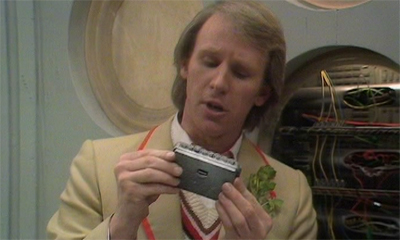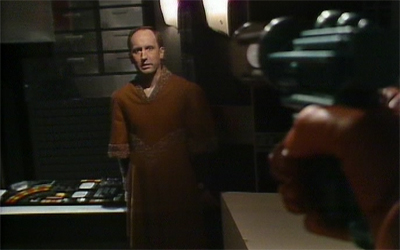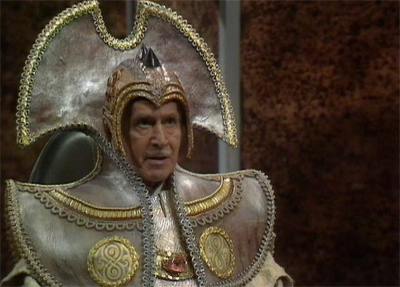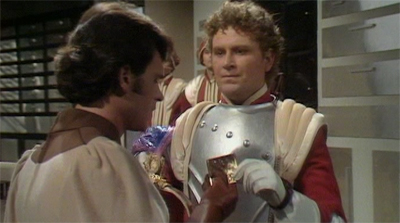To celebrate the fiftieth anniversary of the longest-running science-fiction show in the world, I’ll be taking weekly looks at some of my own personal favourite stories and arcs, from the old and new series, with a view to encapsulating the sublime, the clever and the fiendishly odd of the BBC’s Doctor Who.
Arc of Infinity originally aired in 1983.
We know who you are.
That changes nothing.
– the Doctor and Omega set one thing straight
There really should be a bare minimum threshold of enjoyment for a Doctor Who story set on Gallifrey. I mean, these are beings who claim to control the whole of time and space. Their guards look like they modelled themselves on Adam Strange, replacing his jetpack with a cape, and there’s always an excuse for some good old-fashioned science-fiction ray-gun-related fun. How hard can it be to entertain an audience for four episodes in that particular setting?
Unfortunately, Arc of Infinity answers that question. Quite boring indeed, it seems.
To be fair, this should not be so surprising. Robert Holmes effectively ruined Gallifrey for everybody by writing The Deadly Assassin, probably one of the very best Doctor Who stories ever written. Turning Gallifrey into the space-age equivalent of a British academic institution was an act of creative genius. However, it soon became quite clear that only a creative genius could make that concept interesting. Douglas Adams managed it rather ingeniously in Shada, providing a literal link between Cambridge and Gallifrey, but the other stories set on Gallifrey all fall short.
It’s no wonder, with stories like Arc of Infinity, that the first thing Russell T. Davies removed from the show’s convoluted mythos was Gallifrey and all its associated Time Lords. Arc of Infinity isn’t the first Time Lord story to fail miserably since The Deadly Assassin, and it won’t be the last. However, at least The Invasion of Time had an interesting premise and a nice hook – along with a delightfully over-the-top central performance from Tom Baker. Arc of Infinity is – like far too much of Doctor Who from this period – just a boring and confusing mess.
Part of the problem is that it seems like the writers on the show were unable to appreciate the show on anything other than a literal level. The culture of Gallifrey presented in The Deadly Assassin is divorced from its roots as a scathing satire on academic politics, and instead reimagined as a bunch of boring old men sitting around chatting about the fate of the universe while doing very little. The practical difference between those two concepts might be relatively minor, but Arc of Infinity makes no real connection, acting as if the Time Lords are boring because that’s just what Time Lords are.
Arc of Infinity is indicative of what would become a fairly significant problem with the show in the years ahead, and it stems from that literalism. It seems that, at around this point, the production crew working on Doctor Who decided that the show’s only real worth was as a tribute to Doctor Who. Producer John Nathan-Turner was known to enjoy spending a lot of time at foreign conventions, and his tenure would see the show practically basking in its past, whether through exhibitions like Longleat or in episodes like Attack of the Cybermen and Warriors of the Deep.
Things weren’t important because they were good ideas or bad ideas. Things were important because they were in some way associated with the history of Doctor Who. The show celebrated its tenth anniversary with a four-part event story called The Three Doctors, which cleverly reteamed all three actors to play the lead role. It wasn’t especially fantastic, but it was a nice effort. I’d argue the true celebratory story of that season was Carnival of Monsters, a show with no tangible connection to the series’ past. (And several to the show’s future, with director Barry Letts changing the way the show was shot and an appearance from future companion Ian Marter.)
However, the twentieth season of the show was much more invested in connecting to its past. Not only did the show produce the massive ninety-minute special The Five Doctors, but John Nathan-Turner decreed that ever episode shot in that season would feature a returning monster of some description. Not a returning concept, or a guest star – but a monster. It didn’t matter if the monster was good, or if it suited the story. As long as it was associated with Doctor Who, it would do. This ended up with a gem of a story in Snakedance, but it also led to Arc of Infinity and The King’s Demons.
To be fair, this twist shouldn’t come as a major surprise to anybody watching at home. Nathan-Turner had, for example, decided to use the Master as a familiar bridging monster to help smooth the transition between Tom Baker and Peter Davison in Keeper of Traken, Logopolis and Castrovalva. It is a gimmick, and one which doesn’t really give any intrinsic value to the returning characters. They are important because we recognise them, not because they are especially interesting and compelling.
And that’s the case with Arc of Infinity, which is just a terribly plotted mess. It’s Omega, the character who last appeared in The Three Doctors. One wonders why the show opted to use Omega here when it would go on to invent a suspiciously similar character in Rassilon for The Five Doctors at the end of the year. However, watching the whole of the season, I am perfectly willing to accept that nobody on the writing staff had really thought that far ahead at this point.
Still, what purpose does he serve? What’s his motivation? Who is he? Why do we care? Assuming that Doctor Who is still a show that aims to be appreciated by relatively young children and their family, the writers should understand that some viewers simple weren’t alive when The Three Doctors aired. Even those who were alive might not have been watching. And even those who were watching probably don’t remember the details all that well.
If Arc of Infinity is going to resurrect a one-shot villain from so long ago, it needs to be willing to bring the audience up to speed. And I suppose that it does, in a manner. Confessing his crimes, Hedin explains, “It’s one of us, a Time Lord, the first and greatest of our people. The one who sacrificed all to give us mastery of time and was shamefully abandoned in return.” I suppose that’s something, but it’s a single line of dialogue. Why was he abandoned? How does he know the Doctor? Is there a reason he’s loopy?
It’s just horrible writing. It’s telling that Peter Davison does more to generate sympathy for Omega with a crooked smile at a child in a dialogue-less scene than the entire four-episode script even attempts. Given how Davison wrangles some small measure of pathos from a barely existing scene is a testament to his abilities as an actor, but a condemnation of the serial as a whole. There is the root of a good idea here. Casting Davison as a tragic villain thrown away by a society that doesn’t need him is a compelling hook. Unfortunately, the script couldn’t care less.
The writing here feels lazy, and it’s hard to believe that this could be the same John Byrne who gave us The Keeper of Traken. It’s easy to figure out who the mole is, because he’s the only character acting out of synch with all the other Time Lords. When you can spot the “evil” Time Lord because he’s one behaving reasonably, the script probably has some pretty severe characterisation problems. Of course, the fact that they have to speed up Michael Gough’s distinctive voice in order to (poorly) mask the reveal makes it unintentionally hilarious.
We never really find out why Hedin is doing what he is doing, beyond the fact that it had to be somebody on the inside and it turned out to be the least likely suspect. He’s not insane or mind-controlled, so one assumes that he must have some reason for assisting an omnicidal maniac. Of course, given the clunky dialogue during the reveal, it’s hard to ask for too much more. “I always considered you a friend, Hedin,” the Doctor protests. “A man of learning, respected by all. Why now turn to evil?”
Apparently Hedin thinks the Time Lords have been unfair to Omega, but there’s no sense of what he thinks Omega will do when he’s free, or any hint of hesitation about all the cold-blooded murder involved. Although it doesn’t seem like Omega planned to go so completely off the rails when he got out, what was Hedin’s endgame here? Did he want political and cultural reform? Was he bitter about some past slight from the High Council? Does he believe the Time Lords should be proactive? Instead, there’s nothing.
I’m almost grateful that the show has a strange link to contemporary Amsterdam, if only because it gets us off Gallifrey. This is the type of thing which should be fun. It’s a time corridor linking the most powerful place in the universe to a derelict building in Amsterdam. Given it’s an underground tomb, this is all building to a nice Hinchcliffe-Holmes reference, which never quite materialises. It’s very strange, and very obvious that the location shoot in Amsterdam took place because… well, why not?
There is another additional hook here which should be interesting, but really isn’t. At the end of Time-Flight, the Doctor and Nyssa took off without Tegan, for some reason that isn’t exactly clear even after I just finished watching it. I suspect it was an attempt to generate suspense, but that would require the audience to be invested in Tegan returning to the TARDIS crew. Strangely enough, based on the prologue to Arc of Infinity, Nyssa seems to step into the role of “the assertive, bossy one” when Tegan is away. “Doctor?” she suggests, the embodiment of “no-fun-itude.” “There are many other repairs to do.” I bet that TARDIS was a barrel of laughs.
Anyway, Tegan is rejoining the TARDIS after an absence. She’s had an opportunity to develop as a character and to learn to exist without the Doctor. How did her time in the TARDIS change her? Given we don’t generally revisit past companions (The Android Invasion excluded), this seems like an opportunity the show might want to take advantage of. After all, as I’ve noted in quite a few reviews of the early Davison stories, the show seemed to be gently pushing towards a more serialised “soap opera” crew dynamic.
Unfortunately, it seems that Tegan hasn’t really changed at all during her absence. We join her investigating her cousin’s disappearance, but it seems like it’s pretty casual. Speaking of which, boy does it suck to be related to Tegan, not that anybody mentions her dead aunt. Anyway, there’s no indication that her life has changed that much. She was fired as a stewardess, but we don’t really get a picture of her life as it stands. She doesn’t seem to be proactively doing anything. And then she just sort of stumbles into this situation. (“It’s the sort of thing the Doctor gets up to!”)
Interestingly, we keep hitting on things that the Davison era did terrible which ended up being part of the charm of the Russell T. Davies revival. Much like the soap opera dynamics worked much better under Davies than during the Davison era, Davies actually managed to explore what happens after the Doctor leaves a companion. Let’s just say that Tegan’s arc in Arc of Infinity makes one long for Donna’s re-entrance in Partners in Crime.
Arc of Infinity is just terrible, and a horrible start to the twentieth anniversary year. Unfortunately, it also seems to hint at the shape of things to come.
Filed under: Television | Tagged: Amsterdam, Arc of Infinity, arts, bbc, Deadly Assassin, doctor, DoctorWho, Gallifrey, John Nathan Turner, Keeper of Traken, Nyssa, Omega, Peter Davison, Romana, russell t. davies, science fiction, Story arcs in Doctor Who, Time Lord, Tom Baker |






























Leave a comment